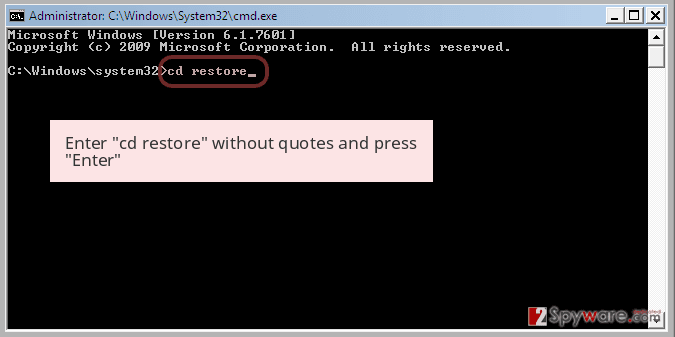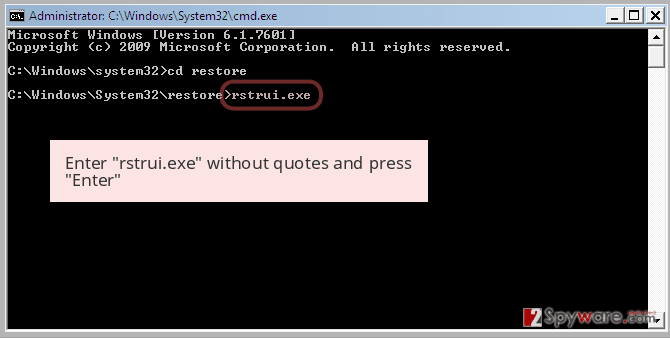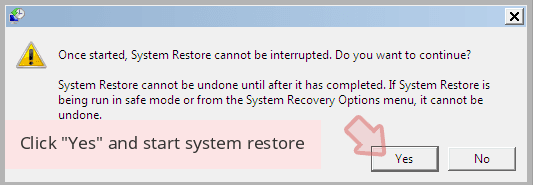BadBlock ransomware / virus (updated Jun 2016)
BadBlock virus Removal Guide
What is BadBlock ransomware virus?
What do you need to know about BadBlock virus?
The number of ransomware threats rises every day, and today we have discovered yet another one. This one is called BadBlock ransomware, and it uses RSA-2048 crypto-system to encrypt victims files, which means that the encryption key is public while the decryption key is kept secret. When this malicious computer infection gets inside victim’s computer, it encrypts practically all files on it, including documents, images, videos, and music. This virus is programmed to find certain file types and encode them, and the list of target file extensions is very long.
Take note that once the file is encrypted, it becomes inaccessible. For example, if it is a picture, you cannot open and view it. If it is a document, you cannot open, edit, or do anything with it at all. In other words, BadBlock malware corrupts all important files so that the victim would not be able to access them. It goes without saying that such unexpected data encryption scares the computer user, and prompt him/her to desperately look for a way to recover the data. Sadly, ransomware is one of the most dangerous computer threats and in the majority of cases the encrypted data cannot be recovered anyhow except by paying the ransom for the cyber criminals.

As you probably have understood, the developers of Bad Block virus seek to convince the victim to pay up in order to recover the data. When the virus finishes with the encryption, it drops several ransom notes on the computer, entitled as Help_Decrypt.txt, and it also sets Help_Decrypt.png file as desktop wallpaper. These ransom notes inform the computer user that the computer got hit by a ransomware virus, and the only possible way to recover data is to pay up. The cyber criminals also state that you can “even remove BadBlock (it’s not that hard), but all your files will become unrecoverable.” They offer to decrypt all files for 2 BTC, which is equal to 900 USD. However, this line in the ransom note should be the main factor to hold you back from paying the ransom:
How do I know that you will really decrypt my files after payment?
You don’t. You have only one choice to recover your files: pay the ransom. We have no interest in keeping your data locked for any reason. So right now, just rely on us […]
Although criminals claim that they have no interest in keeping your files, they might also have no interest in decrypting them for you. Therefore, we warn you to think twice before paying the ransom. We do not recommend you to do that, as you might just lose a considerable amount of money and still have all encrypted data. Therefore, we recommend you to implement BadBlock removal instead of paying up. You can do that with FortectIntego anti-malware program. You can recover your files from a backup if you have such one; we encourage computer users to keep creating data backups because it is the only way to recover your data in case the computer gets infected with ransomware. You might also want to read this post: How to back up your files?
UPDATE: BadBlock virus corrupts essential system files
While commonly ransomware threats are programmed to encrypt all data on the computer except system files, this one is not. The authors of this virus have terribly failed and made this virus capable of encrypting files that are required for the operating system to start. It encrypts Windows executable files, which means the system is not going to start due to “missing or corrupt files” in case the victim decides to reboot the compromised computer. Sadly, victims are not warned that this is going to happen. The ransom note only informs the victim to leave the machine powered after paying the ransom.
What is more, BadBlock virus shows the ransom note immediately after it starts the encryption process. At the bottom of the message, the virus displays what file has been just encrypted. If this message appears on the screen, the user should not panic and should not rush to shut down the computer, because it is not going to help at all. The user needs to open Windows Task Manager and end badransom.exe process immediately. This will stop the process that encrypts files. Then the user needs to remove the virus without a delay. Good news is that victims can now decrypt their files with a help of this BadBlock decryption tool. The most important thing is to keep the computer running and not shut it down.
How did BadBlock infect my computer and when did it happen?
Ransomware can be downloaded to your computer by a Trojan horse, but in most cases, computer users download these viruses by themselves. It happens because many computer users do not know how malware spreads. The most effective way to secure your PC from malware is to install a reliable anti-malware software with a real-time protection feature. Also, you should not wander through suspicious Internet sites and click on pushy web advertisements that pop up on the computer screen when you browse the web. Be aware that malware spreads along fake Java or Adobe Flash player updates, so make sure you do not agree to install these updates from untrustworthy websites. Ransomware can be sent to you via email, so make sure you do not open emails from unknown senders, and especially files attached to them.
How to remove BadBlock virus?
BadBlock ransomware is a very dangerous computer virus, and you should not try to remove it manually if you are not an advanced computer user. You can accidentally delete important system files since ransomware tends to hide its processes under legitimate-sounding filenames. Therefore, we recommend you to use BadBlock removal instructions given below and disable this virus so that you would be able to start an anti-malware program. Again, we do not recommend you to pay ransom for the authors of BadBlock malware, because cyber criminals might not be willing to reveal the decryption key to you.
Getting rid of BadBlock virus. Follow these steps
Manual removal using Safe Mode
Important! →
Manual removal guide might be too complicated for regular computer users. It requires advanced IT knowledge to be performed correctly (if vital system files are removed or damaged, it might result in full Windows compromise), and it also might take hours to complete. Therefore, we highly advise using the automatic method provided above instead.
Step 1. Access Safe Mode with Networking
Manual malware removal should be best performed in the Safe Mode environment.
Windows 7 / Vista / XP
- Click Start > Shutdown > Restart > OK.
- When your computer becomes active, start pressing F8 button (if that does not work, try F2, F12, Del, etc. – it all depends on your motherboard model) multiple times until you see the Advanced Boot Options window.
- Select Safe Mode with Networking from the list.

Windows 10 / Windows 8
- Right-click on Start button and select Settings.

- Scroll down to pick Update & Security.
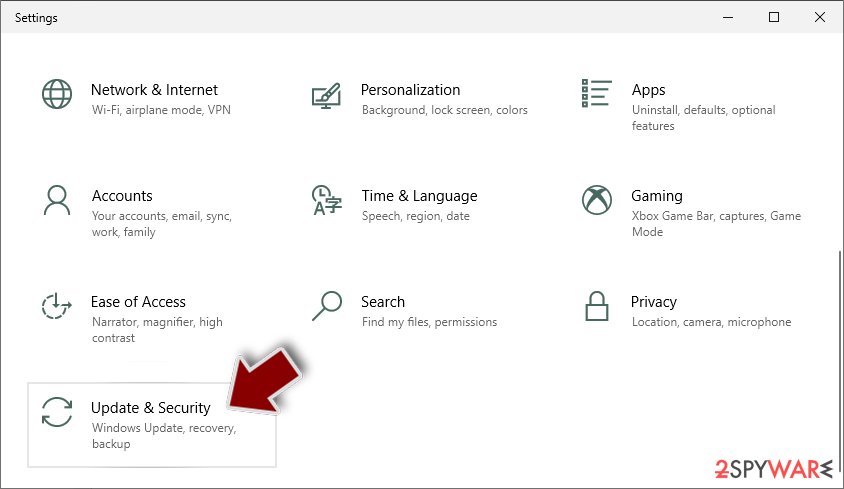
- On the left side of the window, pick Recovery.
- Now scroll down to find Advanced Startup section.
- Click Restart now.
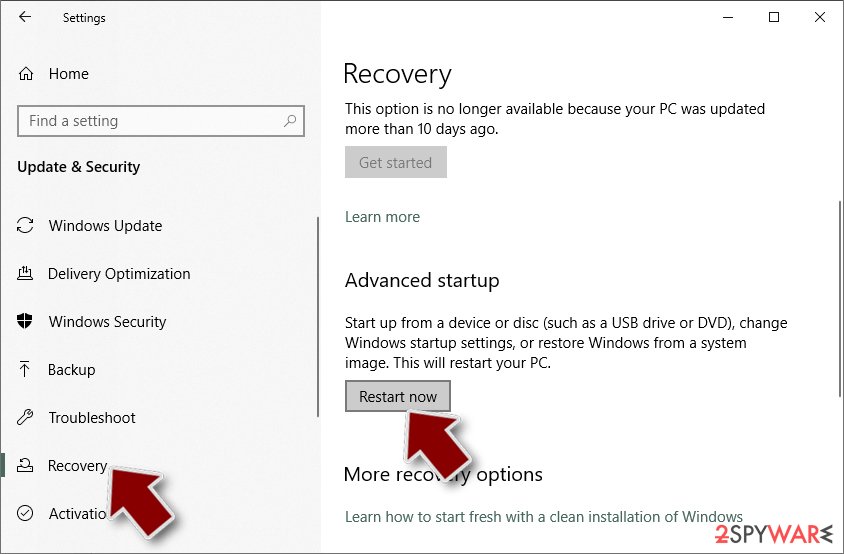
- Select Troubleshoot.
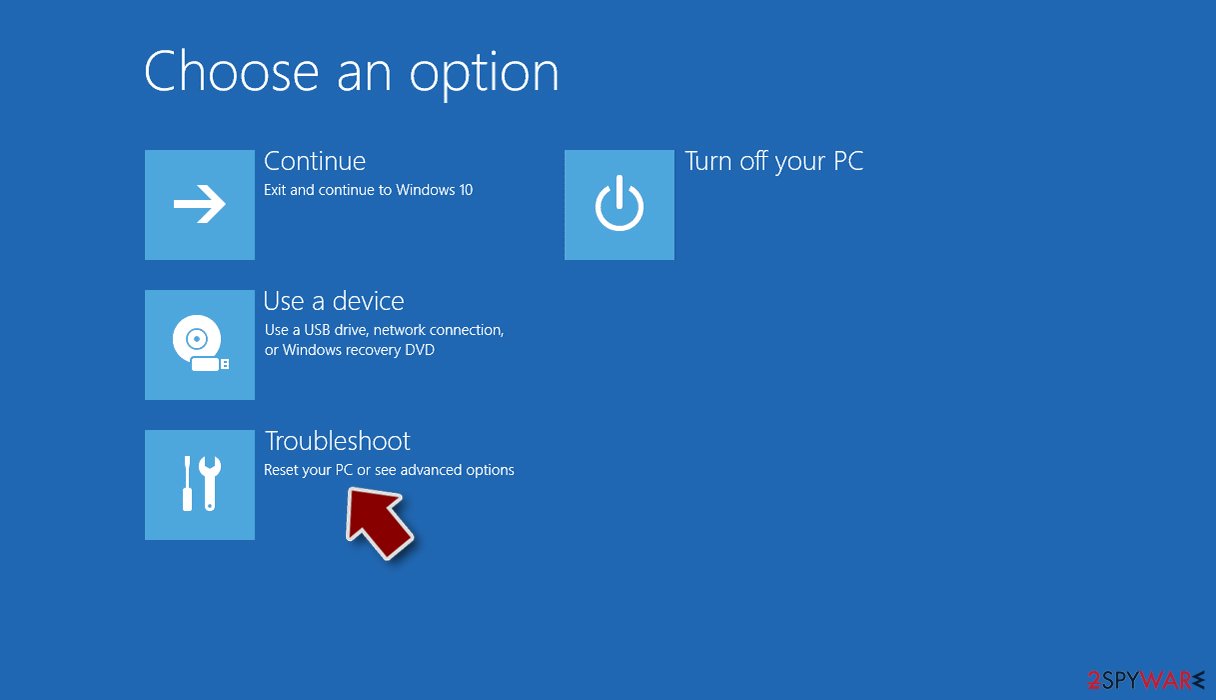
- Go to Advanced options.
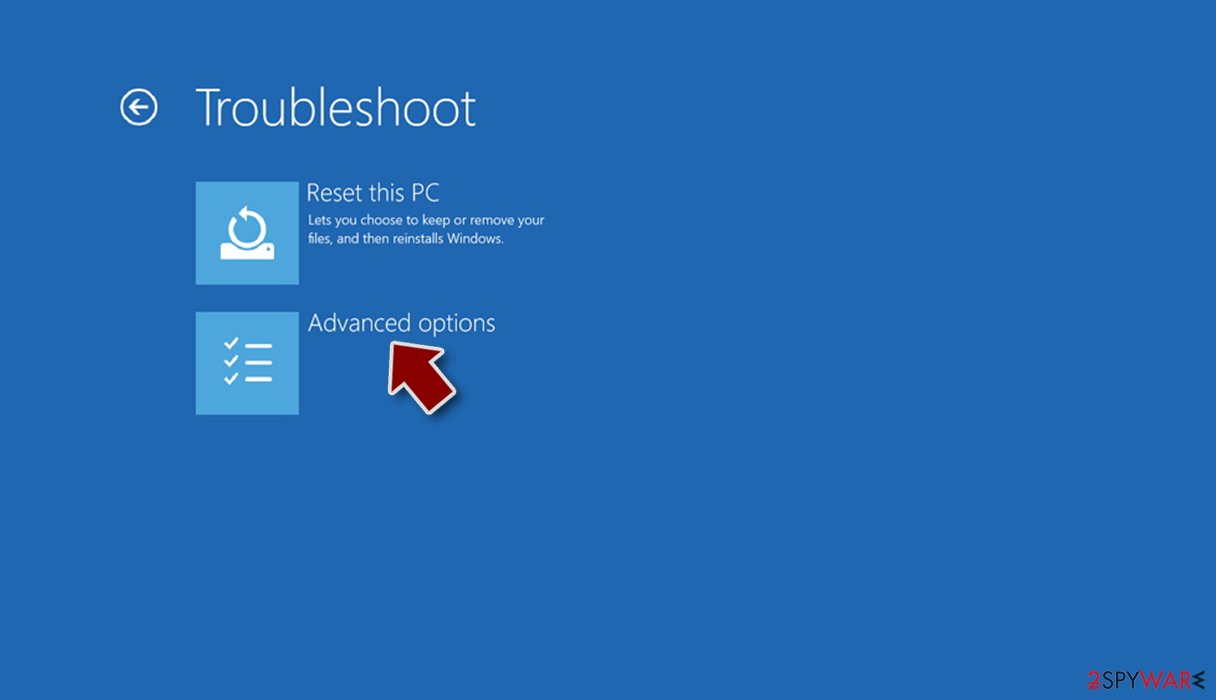
- Select Startup Settings.
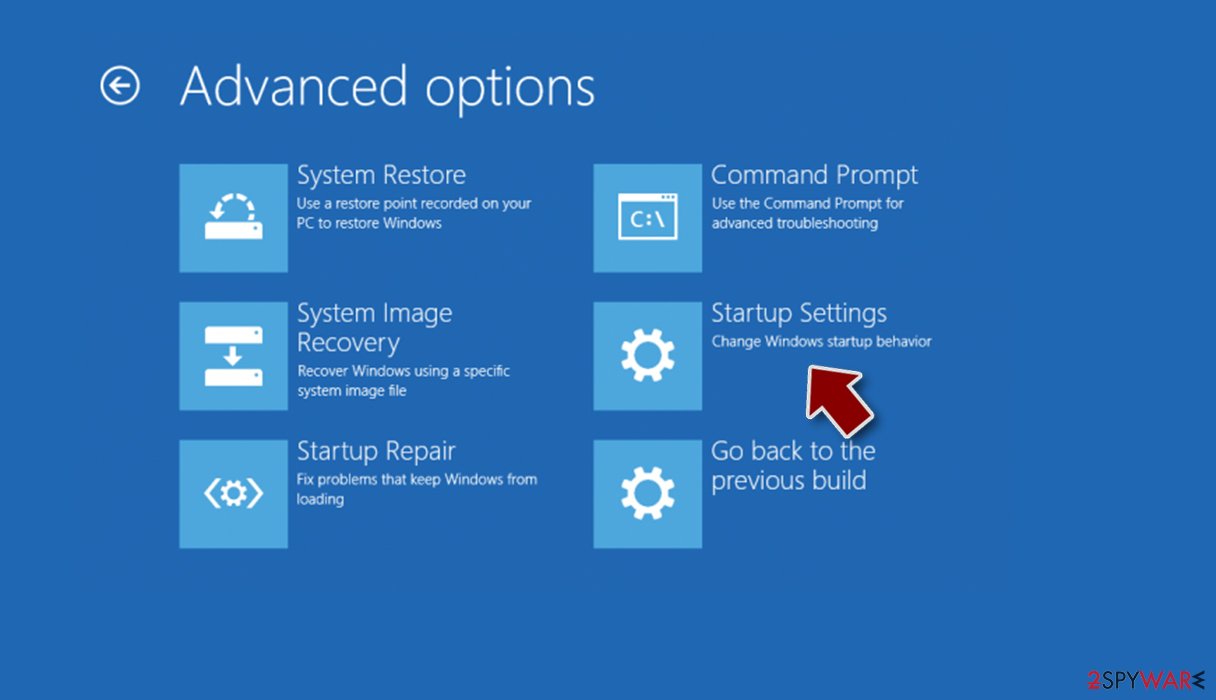
- Press Restart.
- Now press 5 or click 5) Enable Safe Mode with Networking.
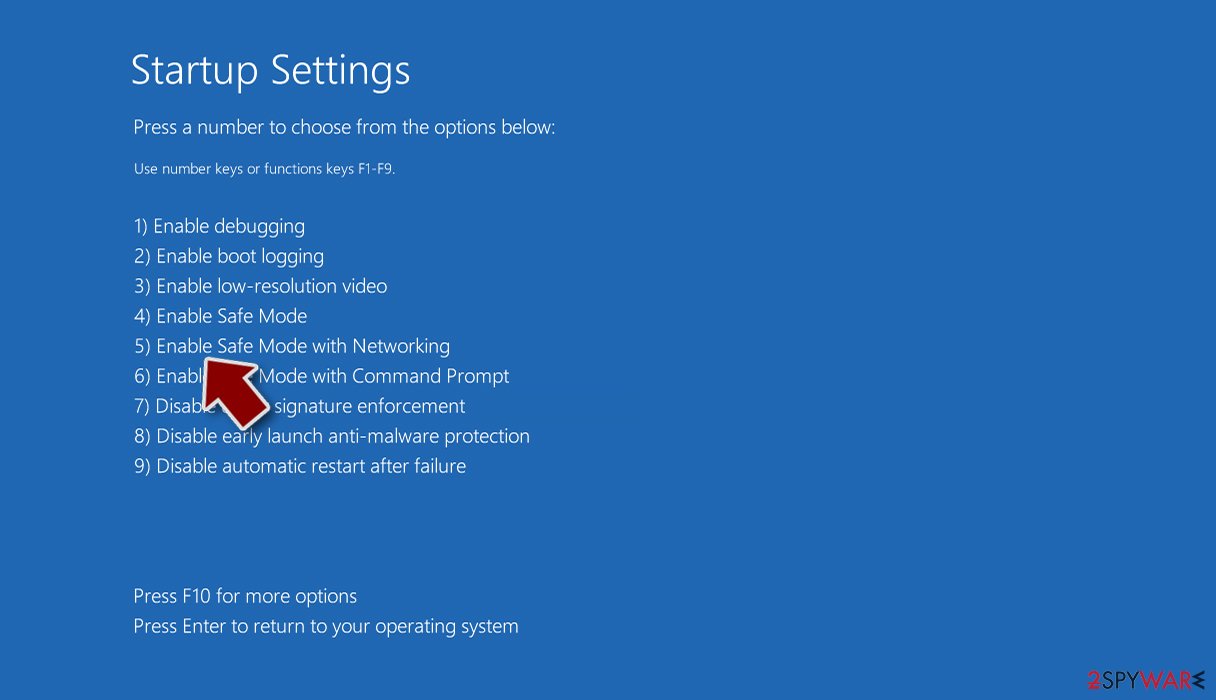
Step 2. Shut down suspicious processes
Windows Task Manager is a useful tool that shows all the processes running in the background. If malware is running a process, you need to shut it down:
- Press Ctrl + Shift + Esc on your keyboard to open Windows Task Manager.
- Click on More details.
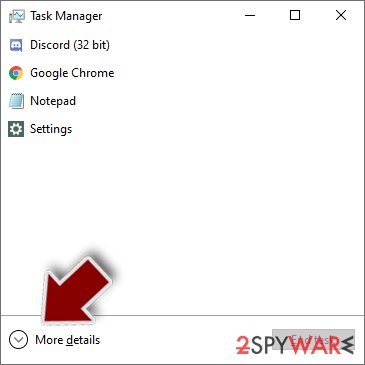
- Scroll down to Background processes section, and look for anything suspicious.
- Right-click and select Open file location.
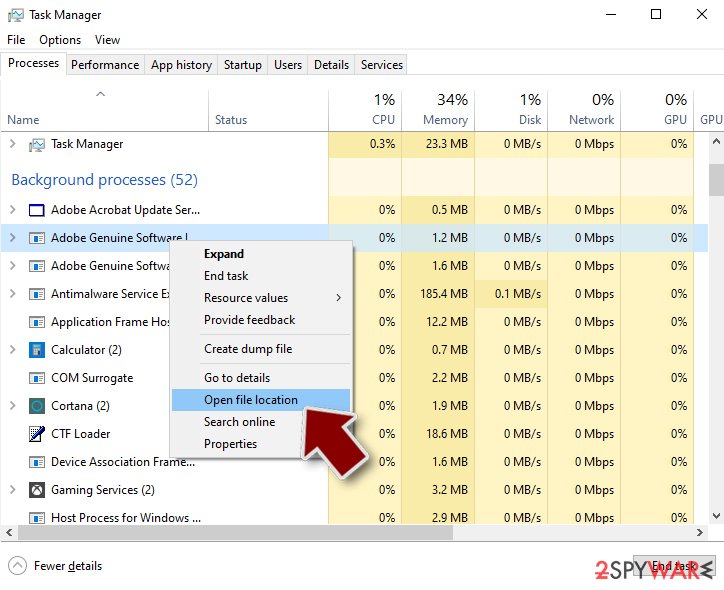
- Go back to the process, right-click and pick End Task.
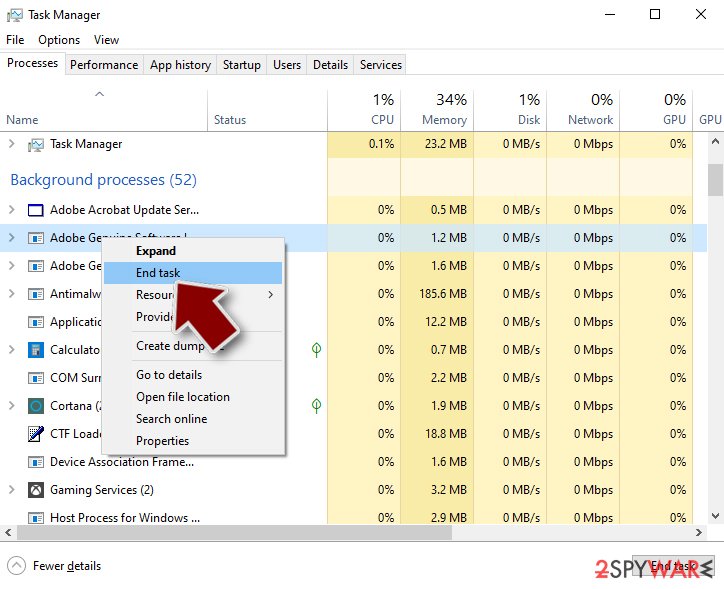
- Delete the contents of the malicious folder.
Step 3. Check program Startup
- Press Ctrl + Shift + Esc on your keyboard to open Windows Task Manager.
- Go to Startup tab.
- Right-click on the suspicious program and pick Disable.
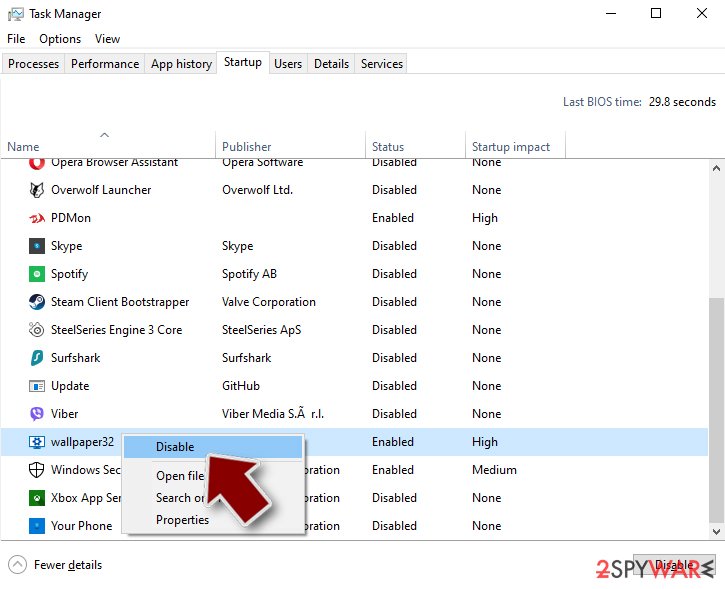
Step 4. Delete virus files
Malware-related files can be found in various places within your computer. Here are instructions that could help you find them:
- Type in Disk Cleanup in Windows search and press Enter.
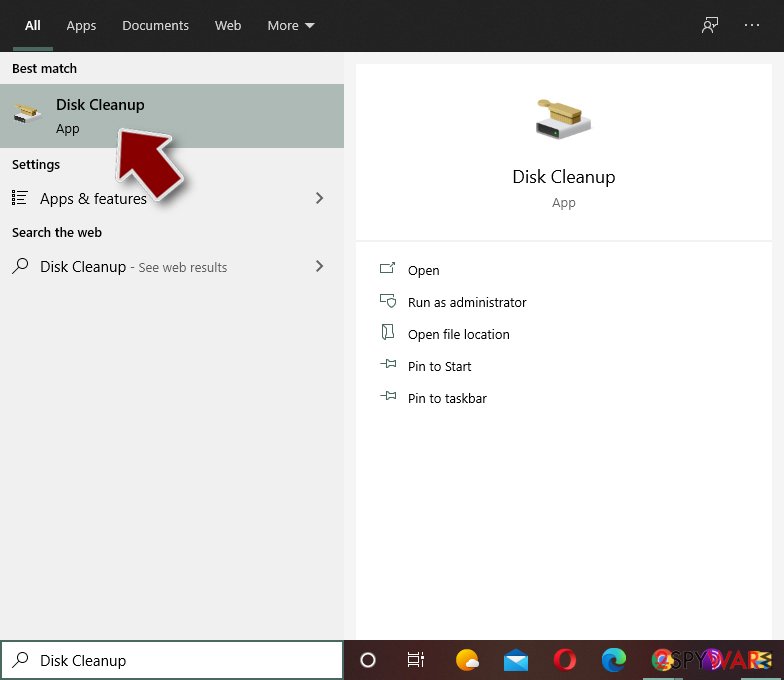
- Select the drive you want to clean (C: is your main drive by default and is likely to be the one that has malicious files in).
- Scroll through the Files to delete list and select the following:
Temporary Internet Files
Downloads
Recycle Bin
Temporary files - Pick Clean up system files.
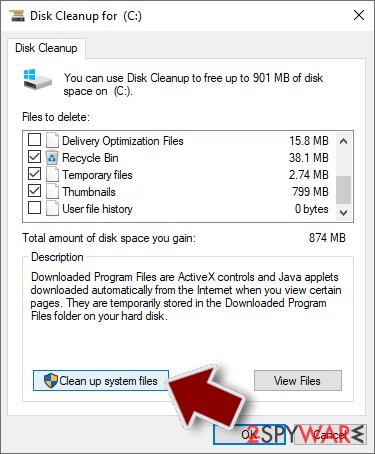
- You can also look for other malicious files hidden in the following folders (type these entries in Windows Search and press Enter):
%AppData%
%LocalAppData%
%ProgramData%
%WinDir%
After you are finished, reboot the PC in normal mode.
Remove BadBlock using System Restore
-
Step 1: Reboot your computer to Safe Mode with Command Prompt
Windows 7 / Vista / XP- Click Start → Shutdown → Restart → OK.
- When your computer becomes active, start pressing F8 multiple times until you see the Advanced Boot Options window.
-
Select Command Prompt from the list

Windows 10 / Windows 8- Press the Power button at the Windows login screen. Now press and hold Shift, which is on your keyboard, and click Restart..
- Now select Troubleshoot → Advanced options → Startup Settings and finally press Restart.
-
Once your computer becomes active, select Enable Safe Mode with Command Prompt in Startup Settings window.

-
Step 2: Restore your system files and settings
-
Once the Command Prompt window shows up, enter cd restore and click Enter.

-
Now type rstrui.exe and press Enter again..

-
When a new window shows up, click Next and select your restore point that is prior the infiltration of BadBlock. After doing that, click Next.


-
Now click Yes to start system restore.

-
Once the Command Prompt window shows up, enter cd restore and click Enter.
Finally, you should always think about the protection of crypto-ransomwares. In order to protect your computer from BadBlock and other ransomwares, use a reputable anti-spyware, such as FortectIntego, SpyHunter 5Combo Cleaner or Malwarebytes
How to prevent from getting ransomware
Protect your privacy – employ a VPN
There are several ways how to make your online time more private – you can access an incognito tab. However, there is no secret that even in this mode, you are tracked for advertising purposes. There is a way to add an extra layer of protection and create a completely anonymous web browsing practice with the help of Private Internet Access VPN. This software reroutes traffic through different servers, thus leaving your IP address and geolocation in disguise. Besides, it is based on a strict no-log policy, meaning that no data will be recorded, leaked, and available for both first and third parties. The combination of a secure web browser and Private Internet Access VPN will let you browse the Internet without a feeling of being spied or targeted by criminals.
No backups? No problem. Use a data recovery tool
If you wonder how data loss can occur, you should not look any further for answers – human errors, malware attacks, hardware failures, power cuts, natural disasters, or even simple negligence. In some cases, lost files are extremely important, and many straight out panic when such an unfortunate course of events happen. Due to this, you should always ensure that you prepare proper data backups on a regular basis.
If you were caught by surprise and did not have any backups to restore your files from, not everything is lost. Data Recovery Pro is one of the leading file recovery solutions you can find on the market – it is likely to restore even lost emails or data located on an external device.


